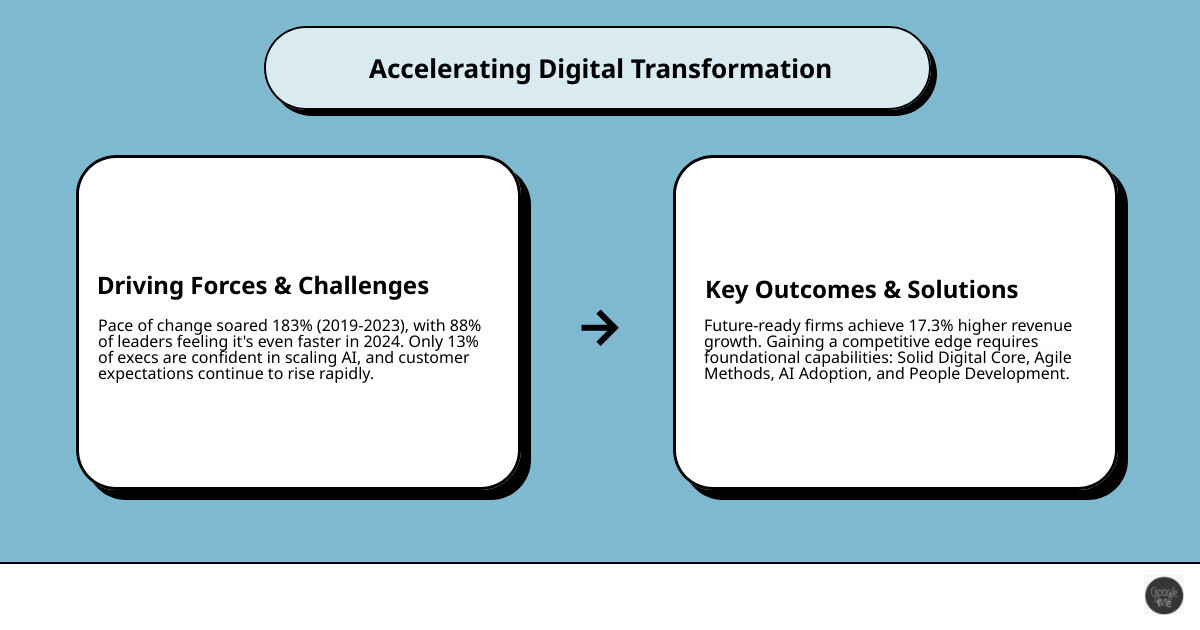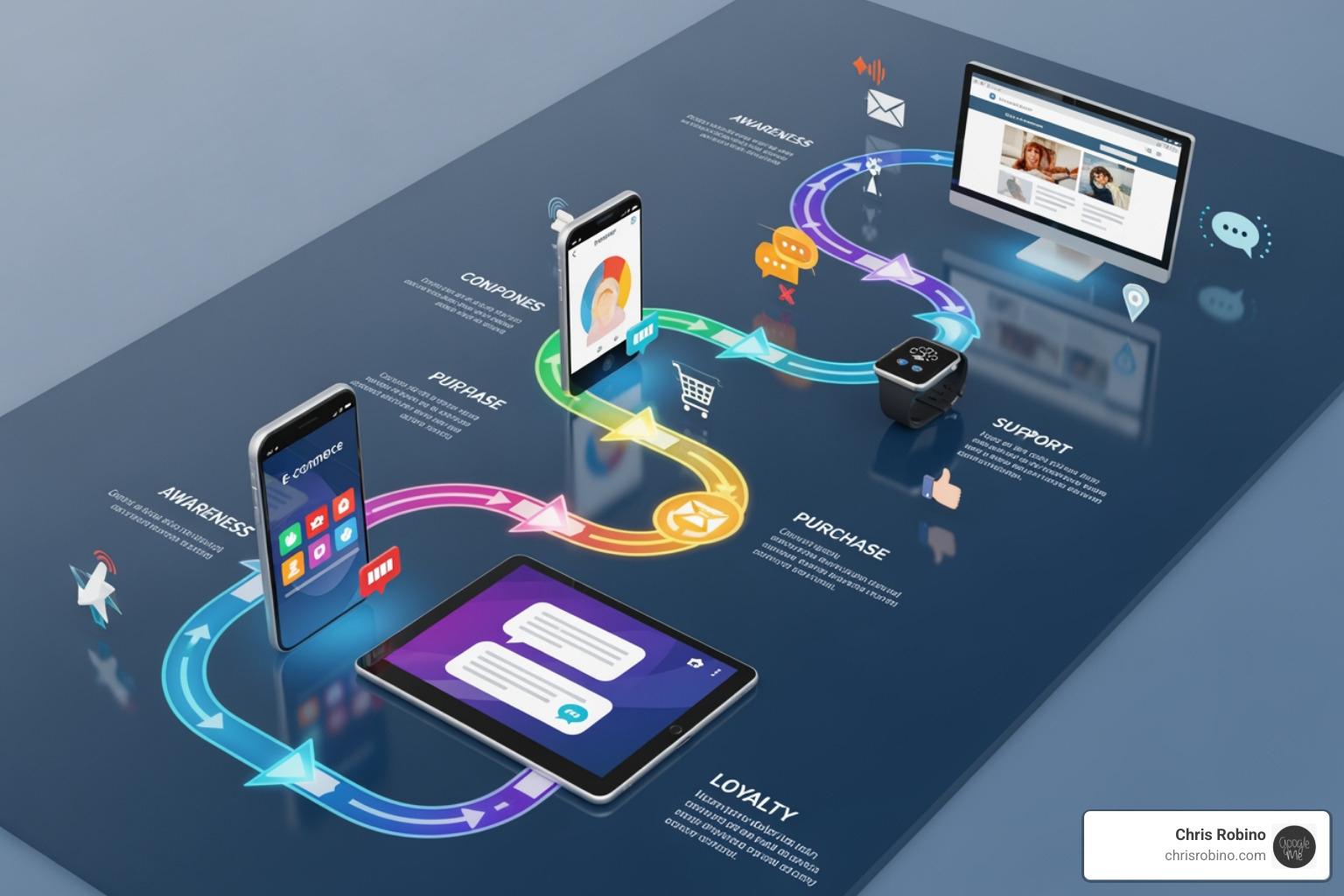Why Speed is the New Competitive Edge
To accelerate digital change is no longer optional—it’s essential for survival. The pace of business change is increasing, with 88% of leaders reporting it’s getting even faster. Companies that master this acceleration, known as “future-ready firms,” achieve 17.3 percentage points higher revenue growth than those who lag.
Quick Answer: How to Accelerate Digital Change
- Build a solid digital core – Cloud infrastructure, data backbone, and composable systems
- Adopt agile methodologies – Move from slow approvals to rapid testing and iteration
- Deploy AI and automation – Free up teams from low-value work to focus on innovation
- Invest in your people – Digital literacy and reskilling drive 15% higher revenue growth
- Stay customer-focused – User-centered design delivers a 20% revenue premium
- Balance speed with governance – Fast execution with robust security and ethics
However, speed without the right foundation leads to chaos and failed initiatives. The solution isn’t just moving faster; it’s about building capabilities that enable continuous, strategic change. This requires a structured approach to technology, processes, and people.
As Chris Robino, I’ve spent over two decades helping organizations steer this challenge. This article breaks down the proven strategies that combine AI-driven systems and data-backed approaches to accelerate digital change while managing risk.

Key Strategies to Accelerate Digital Change
The real work of accelerating digital change goes far beyond buying new software. It’s about fundamentally rethinking how your business operates—from your technology foundation to your team culture. Let’s walk through the strategies that actually move the needle.
Strategy 1: Solidify Your Digital Core for Maximum Velocity
Your digital core is the technological engine that powers your ability to change quickly. It’s an integrated ecosystem of secure cloud infrastructure, a seamless data and AI backbone, and composable systems. A cloud-first approach provides the flexibility and scalability needed to pivot in shifting markets.
The payoff is substantial. Companies with a reinvention-ready digital core achieve the “60:40 effect”: 60% higher revenue growth and 40% greater profitability. This requires actively managing technical debt—the cost of outdated systems. Dedicating around 15% of your IT budget to continuously remediating tech debt prevents innovation from slowing down.
A composable architecture improves this foundation by using modular, interconnected building blocks instead of monolithic systems. This approach minimizes complex integrations, reduces overhead, and allows your technology to adapt as business needs evolve, ensuring a foundation for continuous innovation.
More info about Cloud-Based Computing
Strategy 2: Implement Agile Frameworks to Accelerate Digital Change
While technology provides capability, agile methodologies deliver velocity. However, true agility requires more than just adopting ceremonies; it means overcoming organizational friction. The biggest obstacles are often resistance to change and a lack of leadership understanding.
To make agile work, focus on these practical steps:
- Set SMART Goals: Ensure objectives are Specific, Measurable, Achievable, Relevant, and Time-bound to prevent teams from working without clear direction.
- Use Change Maps: Create visual roadmaps that outline steps and milestones, giving everyone a shared understanding of the change journey.
- Engage Stakeholders Proactively: Identify interests and potential resistance early to build support and mitigate risks.
- Streamline Bureaucracy: Replace slow, committee-based approvals with processes that default to “yes” with proper safeguards. Innovation sandboxes can allow teams to experiment freely without endless approval chains.
Getting these elements right leads to faster results, better alignment, and smoother transitions, which is how you truly accelerate digital change.
More info about Agile Tech Consulting
Strategy 3: Leverage Emerging Tech as a Turbocharger

Emerging technologies like AI and low-code platforms enable entirely new ways of working. AI and machine learning can shrink the software development lifecycle and free teams from repetitive tasks to focus on innovation. Similarly, low-code platforms democratize development, allowing business users to create custom solutions and reduce IT bottlenecks.
The core principle is to automate low-value tasks and build reusable tools like APIs and design systems. This makes it easier for everyone to deliver work quickly and consistently.
However, technology without strategy is chaos. A robust AI governance framework is critical. Owned by the CIO, this framework should prioritize AI initiatives based on business value, set metrics to measure ROI, and ensure adoption is strategic and ethical. Without proper governance, failed AI projects can quickly derail your momentum.
More info about AI-Driven Business Solutions
Strategy 4: Cultivate a People-First, Change-Ready Culture
Technology doesn’t accelerate digital change—people do. The most critical success factor is fostering an organizational culture that accepts change as a constant. This requires transparent communication from leadership and a focus on employee well-being to prevent burnout during rapid change.
Leadership qualities are paramount. The C-suite must champion the strategy together, with CIOs acting as business collaborators, not just IT support. Effective leaders are visionary, data-driven, and skilled communicators who can motivate the entire organization.
Success also depends on two key investments in your people:
- Digital Literacy: Extend tech understanding beyond IT. When all departments grasp the potential and limits of new tools, decision-making and collaboration improve.
- Reskilling Staff: Companies that excel at reskilling enjoy a 15% revenue growth premium. Invest in continuous training to ensure your workforce has the right capabilities.
Finally, incentivize collaboration across departments to break down silos and foster a shared purpose. A people-first culture turns your workforce into the primary driver of change.
Strategy 5: Maintain a Customer-Centric Focus to Accelerate Digital Change

Every effort to accelerate digital change must center on the customer. If an initiative doesn’t improve the customer experience, it needs rethinking. This customer-centricity means designing seamless, valuable experiences across all digital touchpoints.
The business case is clear: organizations focused on user-centered design see a 20% revenue growth rate premium. This approach ensures your solutions are intuitive and solve real customer problems.
To achieve this, prioritize direct customer engagement. Executives should connect directly with customers to understand their pain points and expectations. Use outcome-driven metrics—like customer satisfaction and engagement—to track the real-world value of your initiatives. Putting customers first not only delivers value but also builds lasting loyalty and drives sustainable growth.
More info about Digital Strategy Advice
Strategy 6: Balance Speed with Robust Governance and Security
Moving fast without safeguards is a recipe for disaster. To accelerate digital change sustainably, you must balance speed with strong governance and security.
Embed risk mitigation into your processes from the start. This includes:
- Smart Governance: Create frameworks that enable quick decisions, not hinder them. Use a “default to yes” approach with safeguards to avoid bottlenecks while ensuring accountability.
- Proactive Security: Adopt an intelligence-led security posture. Build resilience into your digital core from day one rather than treating security as an afterthought.
- Ethical AI and Data Privacy: Establish clear guidelines for responsible AI to address bias and protect user data. Adhere strictly to privacy regulations to maintain customer trust.
- Regulatory Compliance: Continuously monitor and adapt to evolving legal and industry standards.
Balancing speed with governance ensures your change is fast, secure, and trustworthy for the long term.
More info about Ethical AI Development
Measuring Success and Sustaining Momentum

Digital change has no finish line. To successfully accelerate digital change is to build an engine for continuous reinvention. The six strategies outlined—a solid digital core, agile frameworks, emerging tech, a people-first culture, customer-centricity, and balanced governance—work as an integrated system to drive innovation.
To know if your efforts are working, you must measure what matters. Move beyond vanity metrics and focus on outcome-driven Key Performance Indicators (KPIs) that reflect business impact, such as:
- Customer Satisfaction and Retention
- Operational Efficiency and Cost Reduction
- New Revenue Streams or Market Share
- Employee Engagement and Productivity
- Time-to-Market for New Services
This shift from one-off projects to perpetual evolution is the core of modern business reinvention. Accept the principle of “progress over perfection.” In a fast-moving world, a good solution delivered today is better than a perfect one delivered in six months. Move quickly, learn from real-world results, and adapt continuously.
As Chris Robino, I help organizations translate these strategies into measurable business value. By integrating AI-driven insights with proven methodologies, we can build a sustainable framework for your continuous reinvention. The journey is unique to you, but by building a strong foundation, putting people first, and never stop improving, you won’t just keep up with change—you’ll set the pace.
More info about Technology Innovation Consulting Firm services
